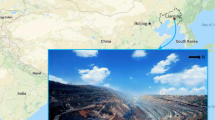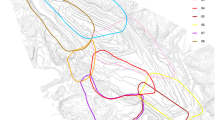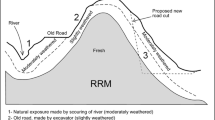Abstract
This article aims to present GAMAH-R as a new mining rock slope classification system, which was applied on three iron mines located in the western Quadrilátero Ferrífero, Brazil. This system allows to determine the slope performance concerning drainage, geometry and deformation aspects based on visual inspection, using a classification chart. Additionally, it was possible to represent all slopes evaluated on a GAMAH-R Map, providing guidance, not only for monitoring, but also to assessment of slopes performance. The performance map of mine A, a hillside mine, shows that predominate T4 slopes, mainly due to erosive processes caused by inefficient drainage system. Mine B, a deep open pit, shows that the slopes belong to classes T5, T4, T3 and T2, due to the failure mechanisms. The mine C, due to some final pit slopes with geometry according to geotechnical sectorization and maintenance drainage system, indicates a predominance of slopes of class T2. Herein, a new methodological failure susceptibility slope analysis correlating the Global Slope Performance Index (GSPI) and GAMAH-R is presented. This correlation, still under study and development in the Ph.D. thesis of the first author, allows to insert the studied slope in a matrix of failure susceptibility, defined as “Matrix of Failure at Mining Rock Slope”. Slopes with medium–high and high failure susceptibility are selected for a stability analysis, with a probabilistic approach using the probability of failure calculation, and slopes with low and medium failure susceptibility can be evaluated using deterministic approach.



























Similar content being viewed by others
Change history
23 July 2021
A Correction to this paper has been published: https://doi.org/10.1007/s10064-021-02374-4
References
Aleotti P, Chowdhury R (1999) Landslide hazard assessment: summary, review and new perspectives. Bull Eng Geol Env 58:21–44
Chemale F Jr, Rosière CA, Endo I (1994) The tectonic evolution of the Quadrilátero Ferrífero, Minas Gerais, Brazil. Precambrian Res 65:25–54
Corominas J, van Westen CJ, Frattini P, Cascini L, Malet JP, Fotopoulou S, Catani F, Van Den Eeckhaut M, Mavrouli O, Agliardi F, Pitilakis K, Winter MG, Pastor M, Ferlisi S, Tofani V, Hervás J, Smith JT (2014) Recommendations for the quantitative analysis of landslide risk. Bull Eng Geol Environ 73:209–263
Costa ISL, Silva GF, Ferreira MV (2019) Application of Zipf’s law to estimate undiscovered Gold endowment in the Quadrilátero Ferrífero Province, Brazil. Journal of the Geological Survey of Brazil 2(3):165–172
CPRM, CODEMIG (2014) Mapa Geológico do Estado de Minas Gerais. Escala 1:1.000.000. Belo Horizonte, CODEMIG, CPRM. Available online at: http://rigeo.cprm.gov.br/jspui/handle/doc/20786
Davis GH (1984) Structural geology of rocks and regions. John Wiley & Sons, New York
Diniz NC (2005) Caracterização Geomecânica de Maciços Rochosos. Dissertação. Faculdade de Tecnologia, Dept. Engenharia Civil & Ambiental Geotecnia, Universidade de Brasília. (In Portuguese)
Ferentinou M, Fakir M (2018) Integrating rock engineering systems device and artificial neural networks to predict stability conditions in an open pit. Eng Geol 246:293–309
Grenon M, Hadjigeorgiou J (2010) Integrated structural stability analysis for preliminary open pit design. Int J Rock Mech Min Sci 47(3):450–460
Hippertt J, Davis B (2000) Dome emplacement and formation of kilometre-scale synclines in a granite–greenstone terrain (Quadrilátero Ferrífero, southeastern Brazil). Precambr Res 102:99–121
ISRM (2007) The complete ISRM suggested methods for rock categorisation, testing and monitoring. In: R Ulusay, JA Hudson (Eds). International Society for Rock Mechanics Turkish national Group, Ankara, Turkey, p 1974-2006
Karam KS, He M, Sousa LR (2015) Slope stability risk management in open pit mines. In: Conference 7th Git4ndm Amd 5th Eogl International Conference. Project: Slope Stability in Rock Formations. UAE University, Al-Ain, p 19
Lee EM, Jones DKC (2004) Landslide risk assessment. Thomas Telford, London, p 454
Marinos P, Hoek E (2000) GSI: A geologically friendly tool for rock mass strength estimation, in Proceedings GeoEng 2000 Conference, 19–24 November 2000, Melbourne, Australia, Technomic Publishing Company, Lancaster, vol. 1, p 1422−1440
Menezes DA, Carneiro SRC, Meireles BP (2019) Map of the potential geotechnical susceptibility for operational pit slopes. REM, Int Eng J 72(1):55–61. https://doi.org/10.1590/0370-44672018720137
Naghadehi MZ, Jimenez R, Khalokakaie R, Jalali SME (2013) A new open-pit mine slope instability index defined using the improved rock engineering systems approach. Int J Rock Mech Min Sci 61:1–14
Pantelidis L (2011) A critical review of highway slope instability risk assessment systems. Bull Eng Geol Environ 70:395–400
Read JRL, Stacey PF (eds) (2009) Guidelines for open pit slope design. Csiro Publishing, p 496
Sjöberg J (1999) Analysis of large-scale rock slopes. Doctoral thesis. Lulea University of Technology, Division of Rock Mechanics
Sullivan TD (2013) Global Slope Performance Index. In: Slope Stability 2013. International Symposium on Slope Stability in Open Pit Mining and Civil Engineering Electronic. (Keynotes). Brisbane, Australia
Van Westen CJ, Seijmonsbergen AC, Mantovani F (1999) Comparing landslide hazard maps. Nat Hazards 20:137–158
Van Westen CJ, Van Asch TWJ, Soeters R (2006) Landslide hazard and risk zonation—why is it still so difficult? Bull Eng Geol Env 65:167–184
Varnes DJ (1984) Lanslide hazard zonation: a review of principles and practice. UNESCO, Paris, p 63
Wesseloo J, Read J (2009) Acceptance criteria. In: JRL Read, PF Stacey (Eds). Guidelines for Open Pit Slope Design. Csiro Publishing, p 221–236
Williams P, Floyd J, Chitombo G, Trevor Maton T (2009) Design implementation. In: JRL Read, PF Stacey (Eds). Guidelines for Open Pit Slope Design. Csiro Publishing, p 265–326
Acknowledgements
The authors thanks to the Núcleo de Geotecnia Aplicada (NUGEO), of the Escola de Minas (EM), of the Universidade Federal de Ouro Preto (UFOP) and the VALE S.A. for the support to the development of this research.
Author information
Authors and Affiliations
Corresponding author
Additional information
The original article contains an error in author name. “Ferreira” was listed twice during processing.
Rights and permissions
About this article
Cite this article
Ferreira Filho, F.A., Gomes, R.C. & da Costa, T.A.V. GAMAH-R: a new mining rock slope classification system. Bull Eng Geol Environ 80, 7287–7308 (2021). https://doi.org/10.1007/s10064-021-02330-2
Received:
Accepted:
Published:
Issue Date:
DOI: https://doi.org/10.1007/s10064-021-02330-2





